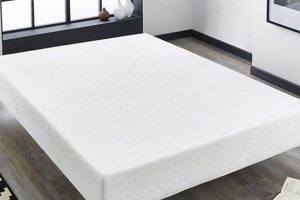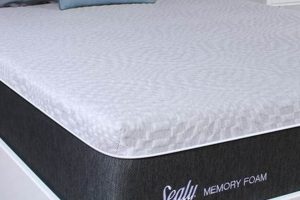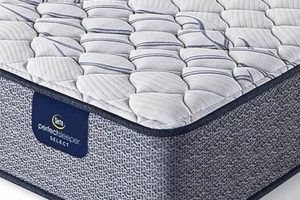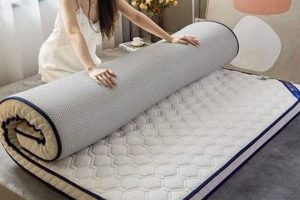The process of resizing a viscoelastic polyurethane foam bed, commonly known as memory foam, involves physically altering its dimensions. This is generally undertaken to fit the mattress to a specific bed frame, to create custom shapes for various applications, or to remove damaged sections. Successfully executing this process requires specific tools and techniques to ensure a clean and accurate result.
Modifying the size of such mattresses can offer significant benefits. It allows consumers to adapt a standard-sized mattress to an antique or non-standard bed frame, preventing the need for complete replacement. Furthermore, resizing can be a cost-effective solution for repurposing a mattress for smaller sleeping areas like RVs or children’s beds. Historically, alterations to mattresses were difficult and imprecise, often resulting in uneven surfaces and compromised support. Modern tools and techniques, however, allow for cleaner and more accurate modifications.
Understanding the optimal methods and required instruments is essential for anyone undertaking this task. The following sections will detail the recommended tools, step-by-step instructions, and crucial considerations for achieving a professionally finished and functional result when altering the size of this specific type of bedding.
Guidance for Modifying Memory Foam Mattresses
The following recommendations aim to enhance the precision and outcome of altering the dimensions of memory foam mattresses.
Tip 1: Employ an Electric Carving Knife. Utilizing an electric carving knife provides a clean, even cut through the dense foam material. The reciprocating blades minimize tearing and ensure a smoother edge compared to using standard knives or saws.
Tip 2: Prioritize Accurate Measurement and Marking. Before initiating any cuts, meticulously measure and mark the desired dimensions on the mattress surface using a fabric marker or tailor’s chalk. Double-check all measurements to prevent errors.
Tip 3: Compress the Foam During Cutting. Applying gentle compression to the foam along the cutting line can improve accuracy and reduce material displacement. This can be achieved by using clamps or weights strategically placed near the cutting path.
Tip 4: Work in a Well-Ventilated Area. The process of cutting memory foam can release fine particles and potentially volatile organic compounds (VOCs). Ensure adequate ventilation in the workspace to minimize inhalation of these substances.
Tip 5: Maintain a Slow, Steady Pace. Rushing the cutting process can lead to uneven edges and potential damage to the mattress. A deliberate and consistent cutting speed allows for greater control and a cleaner finished product.
Tip 6: Consider Using a Guide. Employing a straight edge, such as a metal ruler or wooden board, as a guide can assist in achieving straight, accurate cuts. Secure the guide firmly to the mattress surface to prevent movement during the cutting process.
Tip 7: Preserve Removed Foam for Other Applications. Retain the discarded foam segments for potential use in crafting pillows, cushions, or other padding applications. This can minimize waste and maximize the utilization of the mattress material.
These guidelines are intended to assist in achieving a successful and precise alteration of a memory foam mattress. Adhering to these recommendations can contribute to a professionally finished result and extend the utility of the mattress.
The subsequent section will address common challenges encountered during this process and offer potential solutions.
1. Sharpness of blade
The effectiveness of modifying a memory foam mattress is intrinsically linked to the sharpness of the cutting instrument’s blade. A blade’s sharpness directly impacts the integrity of the cut, influencing both the aesthetic finish and the functional performance of the modified mattress. Insufficiently sharp blades cause tearing and compression of the foam, creating uneven edges and increasing material waste. For example, using a dull utility knife will likely result in a ragged, imprecise cut, while a sharp electric carving knife allows for a clean, uniform slice through the material. The resultant edge will be smoother and maintain its structural integrity.
The type of blade and its sharpness are key components. A serrated blade, when properly sharpened, can “saw” through the foam. However, a smooth, sharp blade, such as that found on an electric carving knife, will slice through with less friction and material displacement. A sharp blade minimizes the force required to cut, reducing the likelihood of compressing or distorting the foam. This is particularly important when working with high-density memory foam, which offers greater resistance to cutting forces. Maintaining a sharp blade necessitates proper maintenance, including regular sharpening or replacement of blades as needed. The economic implications of using a sharp blade extend beyond the quality of the final product. Clean cuts reduce material waste, potentially saving on replacement costs.
In conclusion, blade sharpness is not merely a preference but a prerequisite for successful and efficient modification of a memory foam mattress. It influences the precision, cleanliness, and overall quality of the cut. Prioritizing blade sharpness is fundamental to achieving a professional finish, minimizing material waste, and preserving the functional integrity of the mattress. Choosing appropriate tools and maintaining their sharpness are vital for achieving desired results.
2. Accuracy of measurement
Precise measurement constitutes a foundational element in the successful resizing or shaping of memory foam mattresses. Inaccurate measurements invariably lead to dimensional discrepancies, rendering the altered mattress unsuitable for its intended purpose. For example, if the measurements for fitting a mattress into a custom-built bed frame are imprecise, the resulting mattress may be too large or too small, negating the entire modification effort. The cause-and-effect relationship is direct: flawed measurements precipitate flawed final dimensions.
The practical significance of accurate measurement extends beyond mere dimensional compliance. It influences the overall comfort and support provided by the mattress. Uneven cuts stemming from inaccurate marking can disrupt the intended distribution of weight, leading to localized areas of increased or decreased firmness. This can negatively impact sleep quality and potentially exacerbate existing musculoskeletal issues. In instances where a mattress is being repurposed for a smaller space, such as a camper van, accuracy is paramount to maximizing the available sleeping area.
In conclusion, the accuracy of measurements is non-negotiable when altering memory foam mattresses. It directly affe
cts the mattress’s fit, comfort, and functionality. Challenges in achieving accurate measurements often stem from using inadequate measuring tools or neglecting to account for the mattress’s compressibility. Overcoming these challenges necessitates employing appropriate measuring instruments, such as rigid metal rulers or measuring tapes, and carefully accounting for any potential compression during the marking process. Neglecting this foundational step inevitably compromises the outcome of the entire modification procedure.
3. Control of the tool
Effective manipulation of the cutting instrument is paramount when altering the dimensions of a memory foam mattress. Lack of control inevitably leads to deviations from the intended cutting path, resulting in inaccurate sizes, uneven edges, and potential damage to the mattress. The precision of the cut is directly proportional to the degree of control exerted over the tool.
- Grip and Stability
Maintaining a firm and stable grip on the cutting tool is fundamental for controlled movement. A secure grip prevents slippage and allows for consistent pressure application. For instance, when using an electric carving knife, a loose grip may cause the blade to wander, resulting in an erratic cut. The stability of the operator’s stance is also crucial; a balanced and stable posture facilitates smoother, more controlled movements.
- Speed and Pressure Regulation
The ability to regulate the speed and pressure applied to the tool is essential for achieving a clean and uniform cut. Applying excessive pressure or cutting at an accelerated pace can cause the blade to bind or tear the foam. Conversely, insufficient pressure may result in a jagged, incomplete cut. Skilled manipulation involves a delicate balance between speed and pressure, adjusted according to the density and resistance of the memory foam.
- Following the Cutting Line
Accurate tracking along the pre-marked cutting line requires focused attention and precise hand-eye coordination. Deviations from the line, even minor ones, accumulate and can lead to significant dimensional errors. Employing a guide, such as a straight edge clamped to the mattress, can assist in maintaining a straight cutting path. Regular visual checks and adjustments are necessary to ensure continuous alignment with the marked line.
- Anticipating Material Resistance
Memory foam exhibits varying degrees of resistance depending on its density and composition. An experienced operator anticipates these variations and adjusts their technique accordingly. For example, denser foam may require a slightly slower cutting speed or increased pressure. Recognizing and responding to these changes in resistance is crucial for maintaining control and preventing the tool from binding or skipping.
These facets of tool control collectively determine the quality and accuracy of the cut. Mastery of these skills enables consistent, predictable results, minimizing material waste and ensuring the modified mattress meets the specified dimensions. The ability to effectively manage the cutting instrument is thus a prerequisite for anyone undertaking the task of altering a memory foam mattress.
4. Ventilation of space
The process of modifying a memory foam mattress releases particulate matter and volatile organic compounds (VOCs) into the surrounding atmosphere. Inadequate ventilation during this process exposes individuals to potential respiratory irritants and health risks. Memory foam, composed primarily of polyurethane, can emit chemical compounds during cutting. These emissions, while often low in concentration, can trigger adverse reactions in sensitive individuals, leading to respiratory discomfort, headaches, or allergic responses. A poorly ventilated space concentrates these airborne substances, intensifying the potential for exposure and subsequent health effects. Therefore, adequate ventilation is not merely a comfort consideration but a health and safety imperative.
Implementing proper ventilation strategies mitigates these risks. Opening windows and doors to facilitate airflow creates a natural exchange of air, diluting the concentration of airborne particulates and VOCs. Mechanical ventilation systems, such as exhaust fans or air purifiers equipped with HEPA filters and activated carbon, provide a more controlled and effective means of removing contaminants from the air. For example, a workshop setting where frequent mattress modifications occur should incorporate a dedicated exhaust system to ensure continuous air exchange. A real-world consequence of neglecting ventilation is the potential for long-term exposure to low-level VOCs, which studies have linked to chronic respiratory issues and other health concerns.
In conclusion, ventilation of the workspace is a crucial component of procedures involving memory foam. It directly impacts the health and safety of individuals performing or present during the cutting. Prioritizing proper ventilation through natural or mechanical means minimizes exposure to harmful substances and reduces the risk of adverse health effects. Understanding this connection and implementing appropriate measures is essential for responsible and safe alteration of such mattresses.
5. Support during the cut
Effective alteration of a memory foam mattress necessitates adequate support beneath the cutting line. The absence of proper support leads to material distortion, uneven cuts, and compromised dimensional accuracy. Without a stable foundation, the foam compresses unevenly under the pressure of the cutting instrument, resulting in a beveled or ragged edge. The cause-and-effect relationship is direct: insufficient support precipitates inaccurate cuts.
The practical significance of adequate support manifests in several ways. A stable base minimizes material displacement, allowing for a cleaner, more precise cut that adheres to the marked line. Examples of suitable support surfaces include a rigid table or a large, flat piece of plywood. Strategically placed supports directly adjacent to the cutting line prevent sagging and ensure uniform compression. In instances where the mattress overhangs the support surface, supplemental bracing is crucial to maintain dimensional integrity. Neglecting this aspect can result in significant discrepancies between the intended and actual dimensions of the modified mattress.
In conclusion, appropriate support during the cutting process is an indispensable element. It directly impacts the precision, cleanliness, and overall success. Challenges related to supporting the mattress often arise from using inadequate or unstable surfaces. Addressing these challenges requires careful selection of support materials and strategic placement to ensure uniform pressure distribution. Proper support prevents distortion and ensures the modified mattress retains its structural integrity and intended dimensions.
Frequently Asked Questions
The following addresses common inquiries regarding the process of modifying memory foam mattresses, providing clarification and guidance on best practices.
Que
stion 1: Is it possible to precisely resize a memory foam mattress at home?
Yes, with the proper tools, techniques, and attention to detail, a memory foam mattress can be successfully resized in a home environment. Precision is achievable with careful measurement and a controlled cutting method.
Question 2: What is the most effective tool for cutting memory foam?
An electric carving knife is widely regarded as the most effective tool due to its ability to create clean, even cuts with minimal tearing. Its reciprocating blades efficiently slice through the foam.
Question 3: How should the dimensions be marked on the mattress before cutting?
A fabric marker or tailor’s chalk is recommended for marking dimensions. These tools provide clear, visible lines that are easily followed during the cutting process.
Question 4: What precautions should be taken to minimize inhalation of particles during cutting?
Working in a well-ventilated area is crucial. Opening windows and utilizing exhaust fans can significantly reduce the concentration of airborne particles and volatile organic compounds (VOCs).
Question 5: What type of surface is best for supporting the mattress during cutting?
A rigid, flat surface, such as a sturdy table or a large sheet of plywood, provides the necessary support to prevent uneven compression and ensure a straight cut.
Question 6: Can the removed foam be repurposed?
Yes, the discarded foam segments can be utilized for various purposes, such as creating pillows, cushions, or other padding materials. This promotes resourcefulness and reduces waste.
Accurate measurement, a sharp blade, adequate support, and proper ventilation are key to a successful modification of a memory foam mattress.
The next section will provide guidance on selecting suitable tools and materials for altering memory foam.
Concluding Remarks
This exploration of how to cut a memory foam mattress has outlined the essential steps, tools, and considerations necessary for successful alteration. Emphasis has been placed on precise measurement, appropriate tool selection, adequate support, and the imperative of proper ventilation. These elements contribute to both the quality of the finished product and the safety of the individual undertaking the modification.
The ability to adapt a memory foam mattress to specific needs or spatial constraints represents a practical skill. By adhering to the principles detailed herein, individuals can achieve satisfactory results while mitigating potential risks. The precision and care applied during this process directly influence the comfort, functionality, and longevity of the modified mattress. Prioritizing safety and accuracy remains paramount in ensuring a successful outcome.







